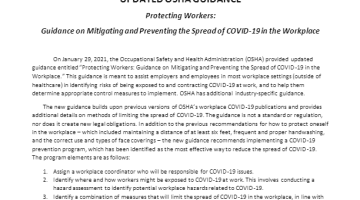On January 29, 2021, the Occupational Safety and Health Administration (OSHA) provided updated guidance entitled “Protecting Workers: Guidance on Mitigating and Preventing the Spread of COVID-19 in the Workplace.” This guidance is meant to assist employers and employees in most workplace settings (outside of healthcare) in identifying risks of being exposed to and contracting COVID-19 at work and to help them determine appropriate control measures to implement. OSHA has additional industry-specific guidance.
The new guidance builds upon previous versions of OSHA’s workplace COVID-19 publications and provides additional details on methods of limiting the spread of COVID-19. The guidance is not a standard or regulation, nor does it create new legal obligations. In addition to the previous recommendations for how to protect oneself in the workplace – which included maintaining a distance of at least six feet, frequent and proper handwashing, and the correct use and types of face coverings – the new guidance recommends implementing a COVID-19 prevention program, which has been identified as the most effective way to reduce the spread of COVID-19. The program elements are as follows:
- Assign a workplace coordinator who will be responsible for COVID-19 issues.
- Identify where and how workers might be exposed to COVID-19 at work. This involves conducting a hazard assessment to identify potential workplace hazards related to COVID-19.
- Identify a combination of measures that will limit the spread of COVID-19 in the workplace, in line with the principles of the hierarchy of controls. Examples include but are not limited to: sending infected or potentially infected employees home, installing barriers where distancing cannot be maintained, improving ventilation, using applicable PPE to protect employees from exposure, and performing routine cleaning and disinfection.
- Consider reasonable accommodations for higher-risk employees through supportive policies and practices.
- Implement a means of communication by which employees can report to the employer COVID-19 symptoms, possible exposure, and possible COVID-19 hazards at the workplace without retaliation from the employer. Also, communication should be effective and in a language, the employee can understand.
- Educate and train employees on COVID-19 policies and procedures using accessible formats and in a language they can comprehend. Training should include: facts about COVID-19 and how it is spread; the importance of face coverings, social distancing, and proper hand washing; the employer’s COVID-19 prevention program; and documentation of who has been trained.
- Instruct employees who are infected or potentially infected to stay home and isolate or quarantine.
- Minimize the negative impact of quarantine and isolation on employees by permitting employees to telework or work in an area isolated from others, if possible. If these options are not possible, allow employees to use paid sick leave, or consider implementing paid leave policies to reduce the risk of transmission.
- Isolate employees who show symptoms at work. Separate them from other employees and other people on site, send them home, and encourage them to seek medical attention.
- Perform enhanced cleaning and disinfection, as recommended by the Centers for Disease Control (CDC), after people with suspected or confirmed COVID-19 have been in the facility.
- Provide guidance on screening and testing. Follow state or local guidance and priorities for screening and viral testing in the workplace. Because individuals may be asymptomatic, health checks should be performed in addition to wearing face coverings and social distancing.
- Record and report COVID-19 infections and deaths. Employers should also report outbreaks to health departments as required and support their contact tracing efforts.
- Implement protections from retaliation and provide an anonymous method for employees to voice concerns regarding COVID-19 related hazards.
- Make a COVID-19 vaccine or vaccination series available at no cost to all eligible employees.
- Do not distinguish between vaccinated employees and those who are not vaccinated for the purpose of implementing safety measures.
- Other applicable OSHA Standards: All of OSHA’s standards that apply to protecting workers from infection remain in place. These standards include: requirements for PPE (29 CFR 1910, Subpart I (e.g., 1910.132 and 133)), respiratory protection (29 CFR 1910.134), sanitation (29 CFR 1910.141), protection from blood borne pathogens (29 CFR 1910.1030), and OSHA’s requirements for employee access to medical and exposure records (29 CFR 1910.1020). There is no OSHA standard specific to COVID-19; however, employers still are required under the General Duty Clause, Section 5(a)(1) of the OSH Act, to provide a safe and healthful workplace that is free from recognized hazards that can cause serious physical harm or death.
OSHA will continue to update the guidance as new developments becomes available. You may find the updated guidance in its entirety here.

